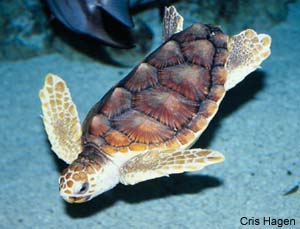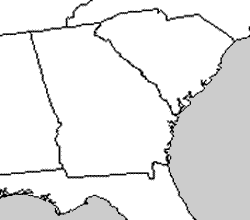Loggerhead Sea Turtle (Caretta caretta)


Photos by Chris Hagen unless otherwise noted
Description: The Loggerhead is a large sea turtle, with females typically more sizable than males. An adult has a carapace length of 75- 112 cm (29.3-43.7 in) and weighs 77-159 kg (170-351 lb). Males are smaller but have longer tails than their female counterparts; they often extend 30 cm (11.7 in) beyond the carapace. As can be inferred from their nomenclature, these sea turtles have an abnormally large head-to-body ratio. Their thick jaw, reddish brown color, and two claws on each flipper distinguish this sea turtle from other species. In addition, the scutes do not overlap, and the first costal scute is in contact with the nuchal scute. There are five or more costals on each side of the carapace and three (usually) or four poreless bridge scutes. Loggerheads also tend to sport more epibiota on their carapaces then other sea turtles (more than 50 species of invertebrates have been found associated with the Loggerhead’s shell). This may be due to their relatively slow swimming speed.
Distribution and Habitat: While these sea turtles can be found from the Canadian Maritime Provinces to Argentina, they nest for the most part in temperate waters, and regularly north to the beaches of the Carolinas. In the winter, they migrate to the southern Atlantic to avoid cold stunning (although they can tolerate lower water temperature than most species of sea turtles). After nest emergence, Loggerhead hatchlings perform a swimming frenzy for days in order to reach the Sargasso Sea. When the small sea turtles are about 150 mm (5.9 in), they make a transatlantic journey from the eastern Atlantic to the western Atlantic. Their journey follows the Gulf Stream and the northern loop of the North Atlantic Oceanic Gyre. At 41-46 cm (16-17.9 in) and possibly 6-10 years of age, they make the return trip to the western Atlantic, remaining in shallow coastal waters for the rest of their lives.
Reproduction and Development: Loggerhead sea turtles nest in open sand dunes from May to October every 2-4 years. Many females exhibit site fidelity, returning to the same beach where they were born or where they nested previously. They lay an average of 115-125 eggs 4-6 times per season at two-week intervals. Nests will incubate for an average of 55-65 days before hatchlings emerge. Warmer incubation temperatures produce more females, while cooler incubation temperatures produce a higher number of males.
Habits: Hatchling sea turtles will frequently feed on small invertebrates and fish eggs found within their sargassum habitat. As they grow larger, their diet shifts to include jellyfish and other invertebrates located near the surface. During their final stage of development, these sea turtles become benthic feeders. Crabs and mollusks make up the majority of the adult Loggerhead’s diet, although they will also feed opportunistically on dead fish. Their powerful jaws can crush even the sturdiest exoskeletons with ease. While fully-grown Loggerheads have few predators (except for sharks and humans), eggs and hatchlings are susceptible to predation from raccoons, hogs, ghost crabs, and fire ants, among others. Once they enter the water, fish and seabirds prey upon hapless newborns.
Conservation: Loggerhead sea turtles continue to be threatened by their most common predator, humans, and are listed federally as an endangered species by the IUCN. Sea turtles often drown at the hand of commercial fishing gear, especially shrimp trawls. The advent of Turtle Excluder Devices (TEDs), which allow sea turtles to escape from fishermen’s nets, have cut down on these losses. Another key issue is habitat destruction and depredation. Notably, the placement of sea walls and jetties causes permanent habitat loss for these animals. Lighting along beaches is an obstruction to sea turtle conservation as it attracts nesting females and causes disorientation in hatchlings.
Pertinent References:
Conant, R., and J. T. Collins. A Field Guide to Reptiles & Amphibians: Eastern and Central North America. 3rd ed. Boston: Houghton Mifflin, 1998.
Gulko, D., and K. Eckert. Sea Turtles: An Ecological Guide. Honolulu: Mutual, 2004.
Jensen, J. B., C. D. Camp, W. Gibbons, and M. J. Elliott. Amphibians and Reptiles of Georgia. Athens: University of Georgia, 2008.
Account Author: Lindsay Partymiller
